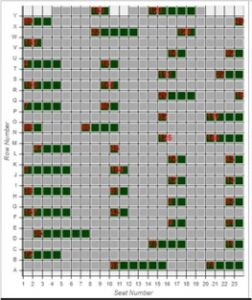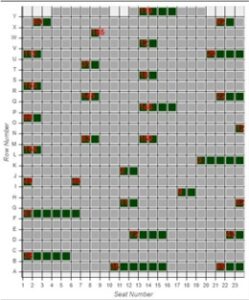How Live Sports Can Achieve Safe Social Distancing
Blending math, analytics and business for a solution that brings fans back in the stands
Posted On: August 14, 2020 By :Sports are a vital part of the fabric of America. Family time, social events and even holidays for some are centered around it. Over the past months, on top of the health and economic concerns wrought by COVID‐19, the lack of sports has added to our yearning for normality.
As cities and communities are slowly beginning to reopen while managing through the pandemic, many of us are asking not only when will sports return but when can people return to stadiums and arenas to watch them in person? While the answer is elusive, we are working to make this a reality using advanced analytics to create recommendations to safely put fans in the stands.
Most states are limiting large gatherings to groups of 10, which poses a formidable challenge. In the short term, a solution is needed to determine the capacity of venues while respecting safe social distancing practices. One solution will not work for every stadium or venue because each has its own unique seating chart, season-ticket holder population and other characteristics.
Strategically, the solution lies in spacing in the venue — determining how many groups should be allowed per row and how many rows of spacing there should be per group. It is important to factor in the types of seats in the venue; while bleachers allow for spectators to climb over or around, chair backs do not offer that same luxury. Older venues often have tighter spacing, while newer stadiums are more spacious.
Secondly, we need to find a tactical solution for venue managers. Who is going to get to attend each event? We have found it essential to preserve groups and not require each individual to be distant from every other person in attendance. Not many people go to a sporting event or entertainment venue to sit there alone — they go to be social and enjoy a good time with friends or family. We can use this element to our advantage and as part of the solution. Families, who presumably have been living together for months, or other groups who have been together during the quarantine, should stay together in the stands. This helps maximize seats, rather than have space between each fan in attendance. More importantly, it also keeps people happy. A team with season-ticket holders might use the solution to help choose which groups can attend specific games, prioritizing longtime fans or in the case of universities, prioritizing major donors.

So how does it all work in action? We used a seating diagram for one section in a college football stadium with chair backs as a test case. In our scenario, we allowed aisle seats, required at least four empty seats between groups, two groups per row, and one empty row between groups sitting in front of each other. This maximized the total value of the groups, where the value corresponded to a potential ranking of groups done by the university. Forty-seven out of the 136 groups could be accommodated, filling just over 24 percent of the seats in the section.

As an alternative, we increased the front‐to‐back spacing to require two empty rows between people sitting behind each other. In this situation, 31 groups could be accommodated, filling 14 percent of the seats. Another alternative is to decrease the number of empty seats between adjacent groups to three. This increased the number of available seats by just under 2 percent. This demonstrates that various social-distancing policies can be rigorously analyzed and be effective with the help of advanced analytics.
We also considered the distribution of how teams sell their tickets. Season-ticket holders, which account for up to 80 percent of attendees of NFL and NBA games, should be prioritized. But if there is a section that is typically empty, a venue manager can determine the sets that are available — four seats or two, etc. – and then can allocate seats for that distribution.
This solution allows venues the flexibility to choose how it can work best for them and their location. But this is just one step. This plan gets fans in the seats but does not solve tailgating, how people enter and exit the venue, concessions, restrooms and parking. Advanced analytics has brought us one step closer to the return of sports; in the spirit of America’s pastime, I have no doubt that analytics can bring us the rest of the way home.
 Irv Lustig, Ph.D., leads the development of custom optimization software at Princeton Consultants. He is an internationally recognized leader in operations research and advanced analytics. He has authored more than 30 articles and scientific papers and is a longtime member of the Institute for Operations Research and the Management Sciences, and a Certified Analytics Professional.
Irv Lustig, Ph.D., leads the development of custom optimization software at Princeton Consultants. He is an internationally recognized leader in operations research and advanced analytics. He has authored more than 30 articles and scientific papers and is a longtime member of the Institute for Operations Research and the Management Sciences, and a Certified Analytics Professional.